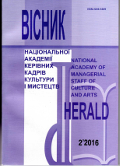PROBLEM OF CULTURE OF THE CRIMEAN KHANATE IN MODERN HUMANITARIAN SCIENTIFIC DISCOURSE
DOI:
https://doi.org/10.32461/2226-3209.2.2016.138506Keywords:
culture of the Crimean Khanate, continuum, interval approach, postmodernismAbstract
The research studies the problem of culture of the Crimean Khanate of XIV-XVI centuries in modern humanitarian scientific discourse. The author reviews literary sources published by various researchers in XVII-XXI centuries. The purpose of the research is to study the sources and to identify different points of view in modern humanitarian discourse, the most appropriate for the analysis of the Crimean culture. The author uses historiographic and comparative methods, which enables to analyze modern cultural methodology of Crimean Khanate study, in particular with the help of interval culture study method, which represents the explication of its culture through intervals. The basis of the research of the interval culture explication of the Crimean Tatar culture in the era of the Crimean Khanate is interdisciplinary correlative integral approach, which combines historical-cultural, general historical, philosophical and art criticism analysis. The scientific novelty lies in the fact that the author proves the necessity to use postmodern methods in modern cultural dis-course, because it promotes deeper multi aspect and many-sided study of the Crimean Khanate as a separate and specific type of culture. Conclusion. The problem of culture of the Crimean Khanate attracted attention of researchers in the sphere of history, art criticism, art history and linguistics many times. It makes most sense to systematize the existed works, in particular by using postmodern methods of the Crimean culture study with the purpose of its future development and objective acceptance by the world community.
Downloads
Published
Issue
Section
License
Authors who publish with this journal agree to the following terms:
1. Authors retain copyright and grant the journal right of first publication with the work simultaneously licensed under a Creative Commons Attribution License International CC-BY that allows others to share the work with an acknowledgement of the work's authorship and initial publication in this journal.
2. Authors are able to enter into separate, additional contractual arrangements for the non-exclusive distribution of the journal's published version of the work (e.g., post it to an institutional repository or publish it in a book), with an acknowledgement of its initial publication in this journal.
3. Authors are permitted and encouraged to post their work online (e.g., in institutional repositories or on their website) prior to and during the submission process, as it can lead to productive exchanges, as well as earlier and greater citation of published work (See The Effect of Open Access).


